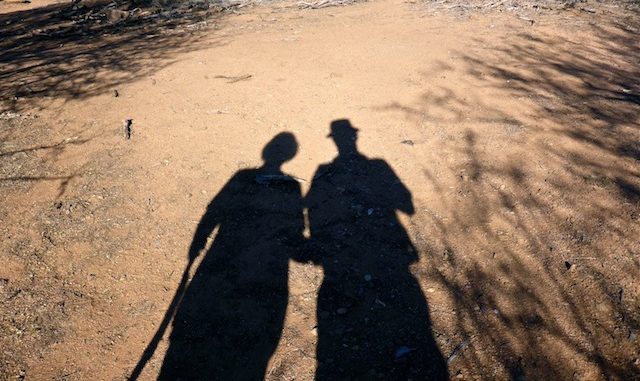
A couple of weeks ago, I began doing long range hike planning. The end result is I have hikes scheduled through the end of April, when I will do my fifth biannual Loop 202 / South Mountain Freeway survey hike. Most of my planned hikes, I not only have slotted into my schedule, but full routes, the whole nine yards! I’m a natural planner, but more so I love maps.
I absolutely love maps. I always have. When I was growing up, my dad’s dream was to be a modern voyageur, rediscovering the Northwest Passage through Canada. As a result, he always had some 1:25,000 topos laying around, on which my 6-year old self would plan battles.
That’s not your normal 1st grade activity, but my favorite book growing up was dad’s West Point Atlas of Military History with maps of every battle the United States, or American colonies, fought from the French & Indian War, in the 1750s, through to the Korean War, 200 years later. I tried playing dad’s Avalon Hill “Battle of the Bulge” wargame, but it was too complex. (For a 6-year old: By modern wargame standards, it was incredibly simplistic.)
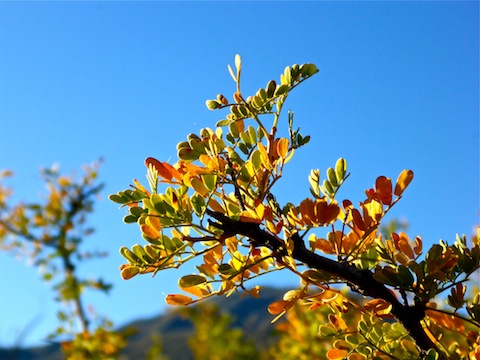
Also, in the late 60s / early 70s, my great uncle Ora McMurry lived maybe 30 minutes away. We visited him often, as he was well into his 70s, and the highlight was always when he would pull out his box of medals: The Croix de Guerre he was awarded as volunteer ambulance driver in the French Army during World War I, then two Distinguished Service Crosses he was awarded as a U.S. pilot after America entered the war.
Those are the reasons why I ended up doing my own 21 year stint in the Army. If not for the Army, I would not have been in that coal mine in Bosnia, where I met my wife, a U.S. Air Force veteran. (You gotta admit, that’s unique!) Now that I think about it, the Army is also where I met my first wife, more prosaically in Signal School at Fort Gordon, Georgia. That first marriage produced my son, Jason, who is also a Army veteran, with a Iraq tour during the Second Gulf War.
So, with Veterans Day on a Friday, my hiking day, this year, I wanted to do a military-themed hike as a way of honoring the veterans who went before my family. As I was poking aroud the topos, doing my general hike planning, I noticed something labelled “Old Camp Reno” in the Tonto Basin, on the low west slope of Mount Ord. That would do nicely.
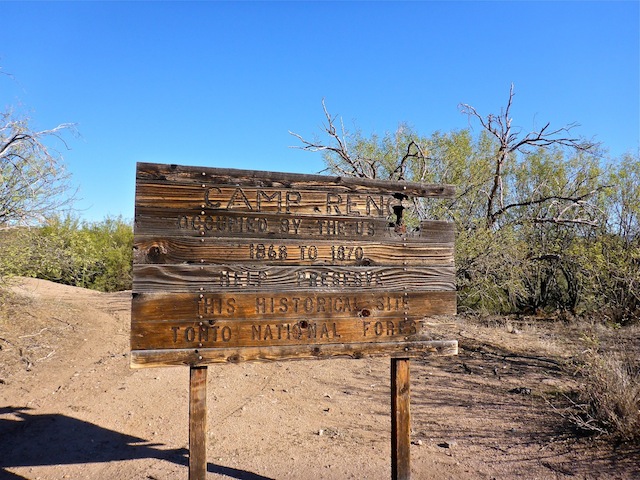
By way of background, Camp Reno was established as an outpost of Fort McDowell. It was built of stone & adobe, on a bluff of what would later be known as Reno Creek. A road over Reno Pass — sensing a theme here? ![]() — connected Camp Reno to Fort McDowell. The camp was only in service from 1868-1870, as the road was difficult, and therefore expensive, to maintain. As early as 1877, the Weekly Arizona Miner was reporting that little remained of Camp Reno. A few scattered recent reports — there’s not much on Google — indicated that trend had not changed over the last 140 years.
— connected Camp Reno to Fort McDowell. The camp was only in service from 1868-1870, as the road was difficult, and therefore expensive, to maintain. As early as 1877, the Weekly Arizona Miner was reporting that little remained of Camp Reno. A few scattered recent reports — there’s not much on Google — indicated that trend had not changed over the last 140 years.
There was more traffic on AZ-87, the Beeline Highway, than last week, but we only encountered one outright asshole driver between home and the village of Punkin Center, where we turned onto FR 409. Thankfully, the Tonto Basin’s dirt roads had dried out since our rainy off road adventure last Friday.
FR 409 runs 2.75 miles from AZ-188 to Old Camp Reno. The road is smooth. At 1.75 miles, there is a split; stay right. After passing by a corral, the road descends. At 2.25 miles, there is a gate. Cars will want to park in the pullout just past the gate, as it gets quite rocky crossing the wash. A lightly loaded SUV, or any high clearance vehicle, can negotiate the wash. It is only a half mile from the gate to Camp Reno’s location.
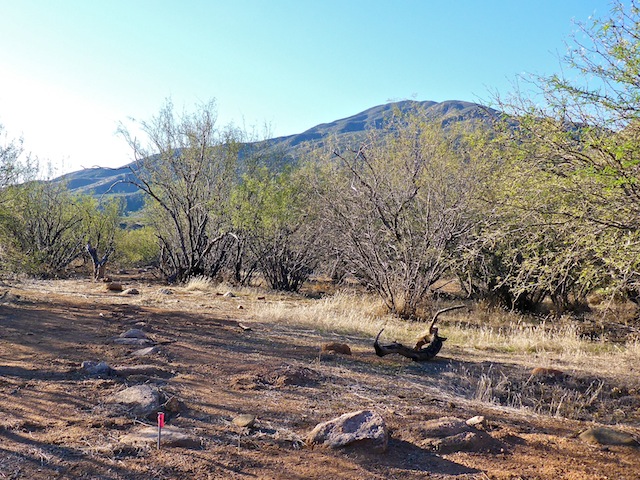
My wife and I had no idea where on the bluff Fort Reno was located, so we began wandering around.
It was not long before started spotting old tin cans, then various types of survey markers: Pink ribbons on sturdy metal pins, a wood stake with a yellow ribbon, wood stakes with abbreviated latitude / longitude (e.g. “4N50W”), white tape draped in the bushes, etc. Due to the arrangement of stones — the Army likes straight lines — it was obvious the pink ribbons marked building corners. My wife has experience in military real estate — yes, that is a thing — but could not decipher the markers. It was obvious, though, that someone has been working on the site, trying to figure out where Camp Reno’s buildings were located.
Most of the cans we found were smaller, like for tinned food, or beverages. There were all extremely rusted, and in pieces. The metal was was quite heavy, probably tin, indicating their age. One had two wedged-shaped punctures, indicating it was 60+ years old. (Pull tabs were invented in 1959.) Only one can had a semi-legible label. I doubt any were from the Camp Reno days, despite tinned rations being in the Army supply chain in the 1860s.
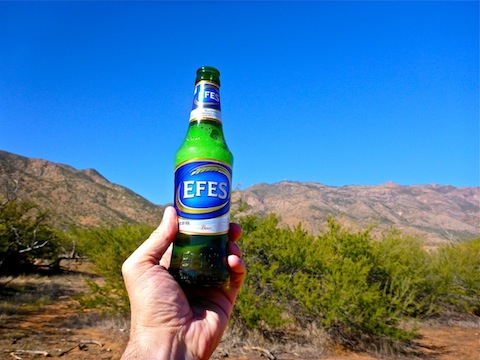
After exploring what we believed was the main area of Camp Reno, my wife returned to our FOB (my SUV), while I set out to do some more exploring. I found the old Moore Ranch, as well as 180 yards of 2-4′ high stone wall. The wall was closer to the ranch house’s foundation than Camp Reno, so I suspect the wall was built by the ranch, rather than the Army. (I found old stone ranch walls in some odd places before, like Hill 3464, near Picketpost Mountain.) Plus, the wall would not have slowed an Apache more than a second.
About that time I started hearing gun fire, and my wife texted me that some hunters were headed my way. I was hoping the hunters would not mistake me for some of the nearby birds I flushed. I decided it was best to bail, rather than continue my explorations, as I was down range of where the hunters were sweeping towards. Down range is never a good thing.
Working my way back towards friendly lines, I encountered an older hunter, resting under a tree. He was hunting with a very well-preserved antique (c. 1926) Winchester Model 12 shotgun. We had a good talk, and I was quite surprised such an old gun could handle hot modern loads. He said it was no problem due to the nickel barrel. I failed to grasp the opportunity when he said he thought it was worth $600-800. It was a sweet piece. ![]()
Back at the FOB, I toasted my fellow veterans on our day by breaking open a 6-pack of Efes Beer, Turkish suds which we literally drank by the Humvee-load when the 432nd Civil Affairs was herding Kurds in northern Iraq after the First Gulf War.
GPS File: Old_Camp_Reno
Distance: 3.28 mi.
AEG: 222 ft.
Time: 2h 00m
Veterans Day Video
Old Camp Reno, Tonto National Forest from Preston McMurry on Vimeo.

Nice video and narrative. I’m a member of the Moore family (Ranse Moore was my great great grandfather) so I’m always interested in what folks find when poking around at Reno.
Small world! Do you remember when the ranch was still up & running?
Ranse died in 1904 and his son William W sold the property sometime after (W W Moore had a ranch on the other end of Reno Pass and then eventually the Box Bar at what is now Rio Verde). Gila County records aren’t as accessible online as Maricopa County and I haven’t had the chance to go search in Globe.
It’s a shame when an old property passes out of the family. Our family has had a lake cabin in Wisconsin for over 100 years that will be someone elses when my cousin (the current owner) passes on. 🙁
Well done! Would be cool to unearth some old images of Camp Reno.
That would be pretty awesome. Especially since photography was a much more complicated process back then.